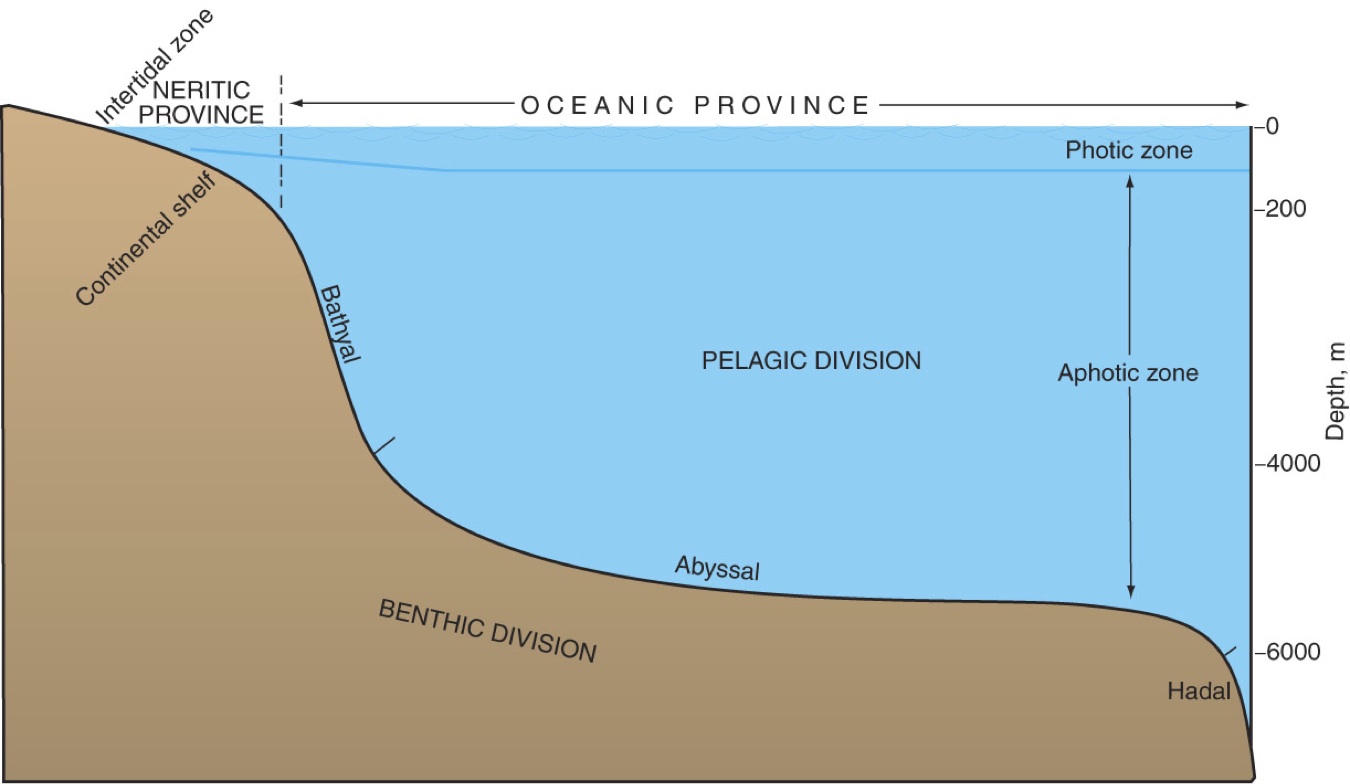| Dept of Biology, Lewis and
Clark College |
|
Dr Kenneth Clifton
|
| |
Biology
221 Lecture Outline
|
|
Lecture 2: Defining the
marine environment
The World's Oceans drive the biology of Planet Earth... How? (climate, O2 availability, nutrient
cycling, etc.)
An understanding of
geological processes is fundamental to marine biology
because....
Geology ultimately
determines most physical and chemical characteristics in marine
environments
Three topics of particular
interest when defining the physical and chemical environment:
Topography,
Chemistry,
History
Why
is topography important?
Water, as a fluid, fills
the shape of its container
Local topography
(shape of ocean floor and coastlines) influences:
Flow (currents,
tides, waves)
Temperature (shallow vs.
deep)
Chemistry (salinity and
other important chemical elements
Why is
chemistry important?
Consider the main
elements used by organisms
Calcium, Hydrogen,
Nitrogen, Oxygen, Phosphorus, Sulfur, and Iron
Availability determined by
geology, physics, chemistry, and biology
These chemicals
circulate between organic and inorganic reservoirs
Biological markers
Elements and isotopes
are an important source of information
Present day studies
(otoliths)
Historical studies
(isotope ratios vs. temperature)
Why
is history important?
Paleo-biology and
paleo-ecology (traces the origins and evolution of life)
Historical events
profoundly influence life on the planet (and in the sea)
Ice ages
Catastrophes (seismic
events, asteroids)
Also... past events
determine availability of fossil fuels...
This often
determines what and where studies take place
Understanding geologic processes
begins with plate tectonics and continental drift
Imagine a simmering cauldron
of soup: Silica croutons, ferrous crust, and magma broth
Sea floor spreading,
subduction, volcanism, and other seismic events (side-side vs.
up-down faults)
Historically, the oceans and continents looked quite different... and that influenced both marine and terrestrial lifeforms.
Some definitions:
Continental
margins
shelf (sediments from
land erosion, turbidity currents send land sediments to the
depths)
slope
trenches
island arcs,
archipelagos
shelf-slope-rise vs.
shelf-slope-islands/trench
Ocean basin floors
soft sediments of:
Plankton skeletons
Clay and other
minerals
Volcanic products
Precipitates (manganese, iron)
Oceanic ridge systems
Centers of divergence: sea-floor
spreading
Evidence:
magnetic anomalies
increasing age of volcanic rock
with distance from ridge
few old sedimentary deposits
(all subducted)
"jigsaw" fit of the continents.
Watching it happen!
Divergence in some areas leads to subduction in others.
Defining oceans and marginal
seas
two views: equatorial vs polar
The Oceans
Pacific
Wide and old
"ring of fire"
Little river drainage, few
seas, determines climate
Atlantic
Narrow and young
Many seas (Gulf of Mexico,
Baltic, Mediterranean, North)
Influenced by rivers
(Mississippi, Nile, Amazon, Congo)
Indian
Smaller
Seasonally moderate
upwelling/productivity
Arctic
Small, seasonally high
productivity
Antarctic
No land boundaries,
high year-round productivity
"Marginal" seas
Restricted flow creates
unique local oceanographic features
high salinity
local currents
unique flora and fauna,
etc.
Classifying marine habitats
What you find depends upon
where you look
Patterns of temperature, light,
nutrition, disturbance, desiccation, etc vary spatially

(figure 1-45 from text)
Some habitats:
Neritic zone (over the continental shelf)
Intertidal
between high and low
tide
Subtidal
Pelagic
zone (Oceanic)
Epipelagic (upper
150 - 200 m or so... linked to the photic zone)
Mesopelagic (150/200 - 1000
m)
Bathypelagic (1,000 -
4,000 m)
Abyssopelagic (4,000 -
6,000 m)
Hadal or "Hadopelagic" (in the
trenches)
"Benthic" zones are on the
bottom
Back
to the Marine Biology Moodle Page
